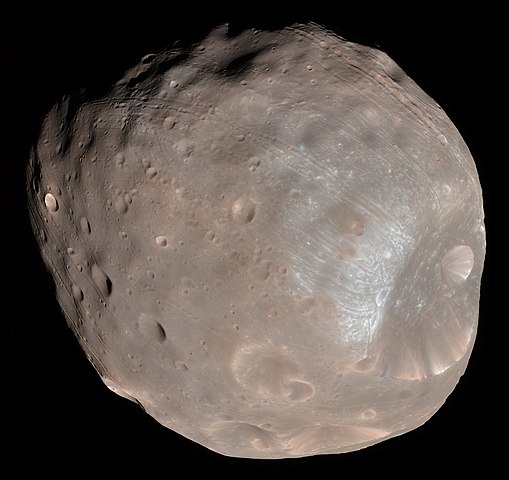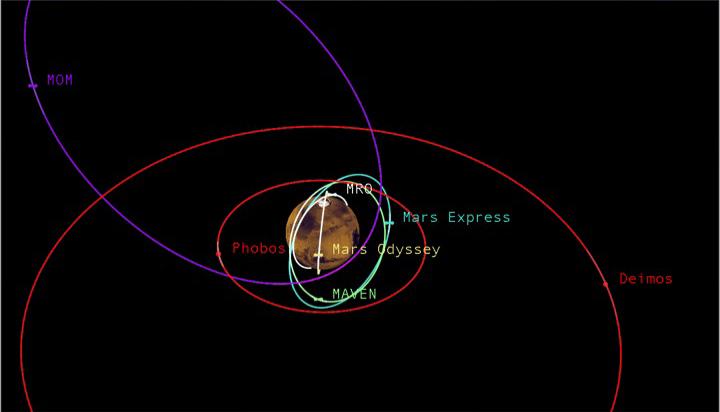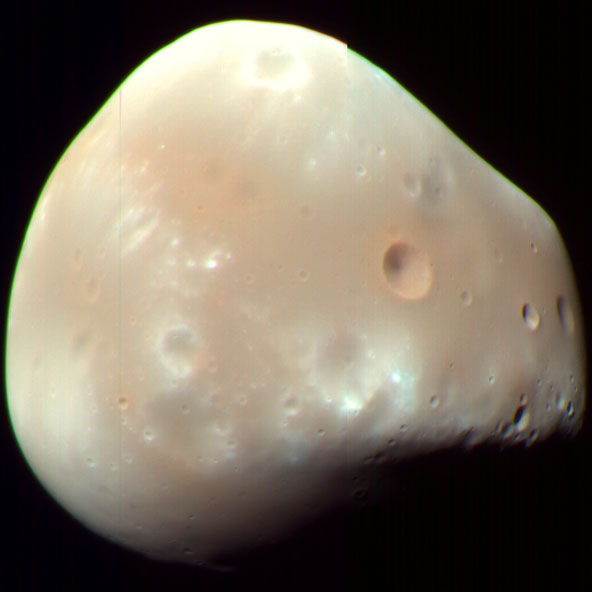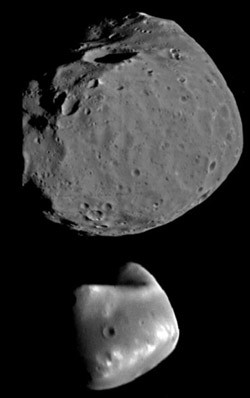The solar system is full of secrets and mysteries, and some of the most enigmatic of all are the two moons of Mars, Phobos and Deimos.
Since they were discovered in 1877 by the American astronomer Asaph Hall, scientists and space enthusiasts alike have sought to unravel the riddles that shroud these distant objects.
In this article, we’ll take a look at the physical and orbital characteristics of Phobos and Deimos, explore their origin and evolution, discuss their discovery and exploration, consider their scientific significance, and discuss the future prospects of these two Martian moons.
Introduction
The first natural satellites of Mars, Phobos and Deimos, are two small, irregularly shaped rocks orbiting the Red Planet at distances of 6,000 and 23,000 kilometers, respectively. They are much less massive than Earth’s moon, with Phobos barely larger than a mountain and Deimos about the size of a small asteroid.
Their surfaces are dotted with impact craters, indicating they have been around for a very long time.
Unlike the Earth’s moon, which moves around its planet in a circular orbit, Phobos and Deimos have highly elliptical orbits that take them far away from the planet during their closest approaches.
They also differ in their eccentricity and inclination, with Phobos having an eccentricity of 0.0151 and an inclination of 1.08°, while Deimos has an eccentricity of 0.0002 and an inclination of 0.93°.
But why do Phobos and Deimos have such unusual orbits? Scientists have proposed several theories to explain it, the most popular being the idea that Mars captured the two moons from the asteroid belt.
This would explain their unusual orbits and their irregular shapes. The capture hypothesis is also supported by evidence suggesting that the solar wind has had an impact on the moons, stripping away material and eroding away their surfaces.
The two moons were first spotted by Hall in 1877, but it was not until the 20th century that they were thoroughly explored. In 1971, the Mariner 9 mission revealed the first ever close-up images of Phobos and Deimos, providing valuable insight into their characteristics and composition. In the decades since, several spacecraft have been sent to study the moons in greater detail, including the Soviet mission Phobos 2 in 1989 and the ongoing Mars Express mission.

The exploration of Phobos and Deimos has yielded several important scientific discoveries. For example, it is now known that they are composed mainly of rock and ice, with some organic molecules.
Scientists have also proposed that the two moons could hold valuable resources that could be used to support future space exploration or even colonization.
The exploration of the moons’ interiors is one of the most exciting prospects in the field of planetary science. There is evidence that Phobos and Deimos may hold clues to the origins of the solar system, and further research could help us understand how our star system evolved.
Additionally, the two moons are potential targets for future mining operations, as they are thought to contain valuable resources such as water and minerals.
Finally, the possibility of colonizing Phobos and Deimos is an enticing prospect, as they are close to Mars and could provide a valuable outpost in space.
This could have a huge impact on our understanding of the Red Planet and our ability to explore and utilize the resources of the Martian system.
In this article, we’ll take a comprehensive look at the physical and orbital characteristics, origin and evolution, discovery and exploration, scientific significance, and future prospects of Mars’ two mysterious moons.
Physical Characteristics
At just 22 kilometers and 14 kilometers in radius respectively, Phobos and Deimos are two of the smallest moons in the solar system. Phobos is the larger and more massive of the two, with a surface area of only 4,700 square kilometers. On the other hand, Deimos is the smaller and less massive of the two, with a surface area of only 1,200 square kilometers.
Both of these Martian satellites have highly irregular shapes, with Phobos appearing more potato-like, while Deimos appears more elongated and oblong in shape.
When it comes to temperature, the two moons of Mars experience extremes. During the day, the surface of Phobos can reach up to a scorching hot -40° Celsius, while Deimos can reach up to -90° Celsius. On the other hand, during the night the temperatures drop drastically and can reach up to -140° Celsius on Phobos and -150° Celsius on Deimos.
The atmosphere of both moons is very thin, with a surface pressure of less than one nano bar and a density of less than one-thousandth of the Earth’s atmosphere.
This means that the surface of both moons is exposed to cosmic rays and other forms of radiation from the sun.
Phobos has a very bright and heavily cratered surface, with numerous large craters that dot the moon’s landscape. It also appears to have a higher porosity than Deimos, and is thought to have been formed by a large number of asteroid impacts.
On the other hand, Deimos appears to have a much darker and smoother surface, with a much lower porosity. The origin of its surface is still a mystery, as is the origin of its craters.
Both of the Martian moons are thought to be covered in a layer of regolith, which is a mixture of dust, rock fragments and other elements. It is believed that this layer of material could be as deep as several meters in places.
The surface of both moons is also likely to be covered in a thin layer of ice, which originates from the solar wind and impacts from comets and asteroids.
Orbital Characteristics
The orbits of Phobos and Deimos are of great interest to astronomers as they are both locked in synchronous rotation with Mars. This means that they each orbit the planet once every 24.6 hours, with Phobos zipping around the planet a little faster at 9,377 kilometers per hour, while Deimos is slightly slower, at 7,359 kilometers per hour. These orbits are relatively elliptical, and Phobos has a greater orbital eccentricity than Deimos, meaning its orbit is more elongated.
The inclination of the orbit also varies greatly between the two moons. Phobos orbits almost in the same plane as Mars’ equator, while Deimos orbits at an incline of 1.8 degrees.
This different orbit could be the result of the two moons being captured by Mars’ gravity in different ways.
Because of their unique orbital characteristics, the two moons can have a meaningful impact on the Martian atmosphere. For example, the tides that are created when Phobos orbits Mars can cause winds on the planet’s surface that reach up to 430 kilometers per hour. These winds can affect the weather and even create dust storms.

The moons’ orbits also give us insight into the history of Mars. The eccentricity of the orbits suggests that the moons have been affected by the cumulative force of the sun’s gravity in the past.
Additionally, the inclination of Deimos’ orbit shows that it was likely captured by Mars’ gravity in a different way than Phobos.
The two moons are also subject to different gravitational effects. Because of the inclined orbital path of Deimos, it is subject to a much greater gravitational pull from Mars than Phobos. This means that Deimos is more affected by tidal forces, leading to its more circular orbit.
The orbits of Phobos and Deimos provide us with a great deal of information about the history of Mars and the forces that have shaped its moons.
By studying their orbits, we can learn more about Mars’ past and the events that have shaped it. We can also gain insight into the future of Mars and the potential of its moons.
Origin and Evolution
The origin and evolution of Mars’ two moons, Phobos and Deimos, remain a mystery. Despite a wealth of scientific knowledge, researchers are yet to answer how the two moons were formed and how they have evolved over time.
The most widely accepted theory suggests that the two moons are captured asteroids, which were pulled into Mars’ gravity field and stayed in orbit. It is believed that the asteroid was broken up by the gravitational force of Mars and each of the pieces created the two moons, Phobos and Deimos.
The solar wind has also had a significant impact on the two moons. The solar wind has caused erosion on the surface of Phobos and Deimos, which has resulted in the formation of deep grooves and craters on the two moons.
As the solar wind continues to act on the two moons, the features will become more pronounced and the moons will continue to evolve.
The impact of the solar wind is made even more significant due to the fact that both moons do not have an atmosphere to protect them.
Without the protection of an atmosphere, the solar wind has been able to cause increased erosion on the moons.
The lack of an atmosphere also means that the two moons are exposed to extreme temperatures. In the day, temperatures on Phobos and Deimos can reach as high as 100 degrees Celsius, while in the night, they can drop to as low as -73 degrees Celsius.
These extreme temperatures have caused the surfaces of the moons to become extremely dry, resulting in a layer of dust and regolith on the surface.
The further evolution of the two moons will also depend on the gravitational forces of Mars. As the two moons move further away from Mars, their orbits will become more elliptical, resulting in a larger distance between the two moons and Mars.
This will have a significant effect on the moons’ evolution as they are subjected to an increased amount of gravitational pull from Mars.
It is clear that the origin and evolution of Mars’ two moons, Phobos and Deimos, is closely linked to the gravitational forces of Mars, the solar wind, and the extreme temperatures on the surface of the two moons. As researchers continue to unravel the mysteries of the two moons, they will gain a better understanding of the history and evolution of the two moons.
Discovery and Exploration
The discovery of Mars’ two moons, Phobos and Deimos, has a long and remarkable history. The first sighting of the moons was made in 1877 by the renowned astronomer Asaph Hall, who was searching for the “missing” ninth planet at the time.
Hall noticed two faint objects orbiting around Mars, and based on their orbits and size, he correctly concluded that they were Martian moons.
The first mission to study the Martian moons was the Mariner 9 spacecraft which was launched in 1971. Mariner 9 was the first spacecraft to ever enter orbit around another planet, and it was able to take the first detailed images of both Phobos and Deimos.
The spacecraft not only provided detailed images of the moons but also measured their orbital characteristics and properties, such as their shapes and mass.
In 1976, the Viking 1 spacecraft launched the first successful flyby of one of the Martian moons. The spacecraft flew by Phobos at a distance of only 5,500 km, providing a more detailed look at the moon than ever before. The flyby revealed the intricate patterns of grooves and fractures present on the moon’s surface.

In 1988, the Soviet Union launched the Phobos 1 and 2 spacecraft. These spacecraft were designed to fly by and study both moons from a closer range than ever before. Unfortunately, both spacecraft failed before they could reach their destination.
In recent years, several more spacecraft have been sent to study the Martian moons. The Mars Global Surveyor spacecraft provided detailed images of Phobos and Deimos from a distance of only 500 km.
The Mars Reconnaissance Orbiter was able to map out the entire moon’s surface in unprecedented detail. In 2011, the Mars Odyssey spacecraft was launched, which is currently studying the moons from its orbit.
Finally, in 2018, the Japanese spacecraft Hayabusa 2 was launched. Hayabusa 2 is the first mission that has been sent to land on one of the Martian moons. The spacecraft is currently heading towards Phobos and is scheduled to land on the moon’s surface in 2021.
The discoveries made by all of these spacecraft have greatly increased our knowledge of the Martian moons. Scientists now have a much better understanding of the moons’ physical characteristics, orbital characteristics, and origin and evolution. The discoveries have also helped to inform future exploration and research.
Scientific Significance
Today, we have a better understanding of the two moons of Mars, Phobos and Deimos, than we did when they were first observed in the late 18th century. In the modern age, their scientific significance is as great as ever, with research into their composition and structure unlocking exciting new possibilities.
The Martian moons are of particular interest to planetary scientists as they may have formed during the primordial epoch of the Solar System. Due to their small size, they have been relatively well-preserved since the formation of the Solar System.
This makes them an invaluable source of information. As such, research into their structure and composition is of great scientific importance.
The interior structures of both Phobos and Deimos are of particular interest because of their potential to provide clues to the origin and evolution of the Martian moons. Studies of their internal structure could reveal the materials that formed them, and how they were formed. Such insight could provide an unprecedented glimpse into the history of the Solar System.
Exploration of the Martian moons has been largely limited to remote sensing techniques, such as radar, but this could soon change. Future probes have the potential to collect samples directly from the surface of the moons, and the data they contain could be invaluable.
The analysis of such samples could provide information on the chemical and mineral composition of the moons, as well as information on the geological history of the Solar System.
The exploration of the Martian moons could also lead to the discovery of valuable resources. The structure of the moons, and the composition of their surfaces, may contain evidence of water ice, which could be mined for use as a fuel source. Additionally, the moons may contain other valuable minerals, such as titanium and iron.
The exploration of the Martian moons is of great scientific importance. It could provide new insights into the origin and evolution of the Solar System, as well as uncover valuable resources that could be used to further space exploration.
The data and materials that could potentially be gathered from the moons could be invaluable to the space industry and could help to open up a new era of space exploration.
Future Prospects
The future of Mars’ two moons, Phobos and Deimos, is filled with possibilities. Scientists have hypothesized that the moons could hold a wealth of resources just waiting to be tapped. Exploring these small worlds could provide insight into the evolution of the Martian system and could even reveal new opportunities to utilize their resources.
The moons could provide the raw materials necessary to build space stations and other habitats in the Martian environment. The material mined from Phobos and Deimos could be used to construct habitats in orbit or on the Martian surface. Mining operations on the moons could also be used to fuel spacecraft and other interplanetary vehicles.
Another potential use of the moons is as refueling stations or fueling depots for spacecraft. The low gravity environment of the moons could potentially allow for the creation of fuel depots, allowing spacecraft to refuel without having to land on the Martian surface. This could open up a wealth of possibilities for future exploration and scientific missions.
The scientific community has also speculated that the moons could be used as research platforms, providing scientists with an ideal environment to study the Martian environment.

The low gravity of the moons could allow scientists to study phenomena such as the dynamics of dust and debris that cannot be studied on the Martian surface. This would open up new opportunities to understand the Martian environment and its evolution.
The possibility of human colonization of the Martian moons is also being discussed. The environment of the moons, while still hostile to humans, could be made habitable by enclosing them in artificial habitats.
This could make them an ideal location for long-term exploration and study of the Martian environment.
Lastly, there is also the potential for robotic exploration of the moons. The moons could be used as bases for robotic exploration of the Martian system, providing access to parts of the surface and atmosphere that are inaccessible from the ground. This could lead to the discovery of new resources and further insight into the evolution of the Martian system.
The future of Mars’ two moons, Phobos and Deimos, is filled with possibilities. Scientists continue to speculate on the potential uses of these small worlds and the possibilities that they may hold.
With further exploration and study, it may be possible to unlock the secrets of the Martian environment and unlock the potential of these two small moons.
Conclusion
The moons of Mars, Phobos, and Deimos, have long been shrouded in mystery. This article has provided an overview of the scientific knowledge about them, including their physical characteristics, orbital characteristics, origin and evolution, discovery and exploration, scientific significance, and future prospects.
From the data collected by various missions, we now have a better understanding of these two bodies. We know that both Phobos and Deimos have irregular shapes and are relatively small compared to other moons in the solar system. Their orbits are highly eccentric and inclined compared to other moons, and they are believed to have been captured by Mars.
Exploration of these two moons has also been an important area of research. The first sighting of them was made in 1877, and since then, various satellites and probes have been sent to study the features and origins of these two bodies. To date, only one mission has successfully landed on Phobos and returned data, and the second mission is currently in progress.
The exploration of the two moons has led to some interesting discoveries. It has been found that the interiors of both Phobos and Deimos are potentially rich in resources, and they could be of great value to future space exploration and colonization. Moreover, studying the composition and environment of the moons could lead to further insights into the origins of the solar system and our universe.
In conclusion, the exploration and study of Phobos and Deimos have been a fascinating and rewarding journey. These two bodies have provided us with a wealth of knowledge about our own solar system and beyond.
With further research and exploration, we can expect to uncover even more secrets hidden in the depths of these mysterious moons of Mars.
